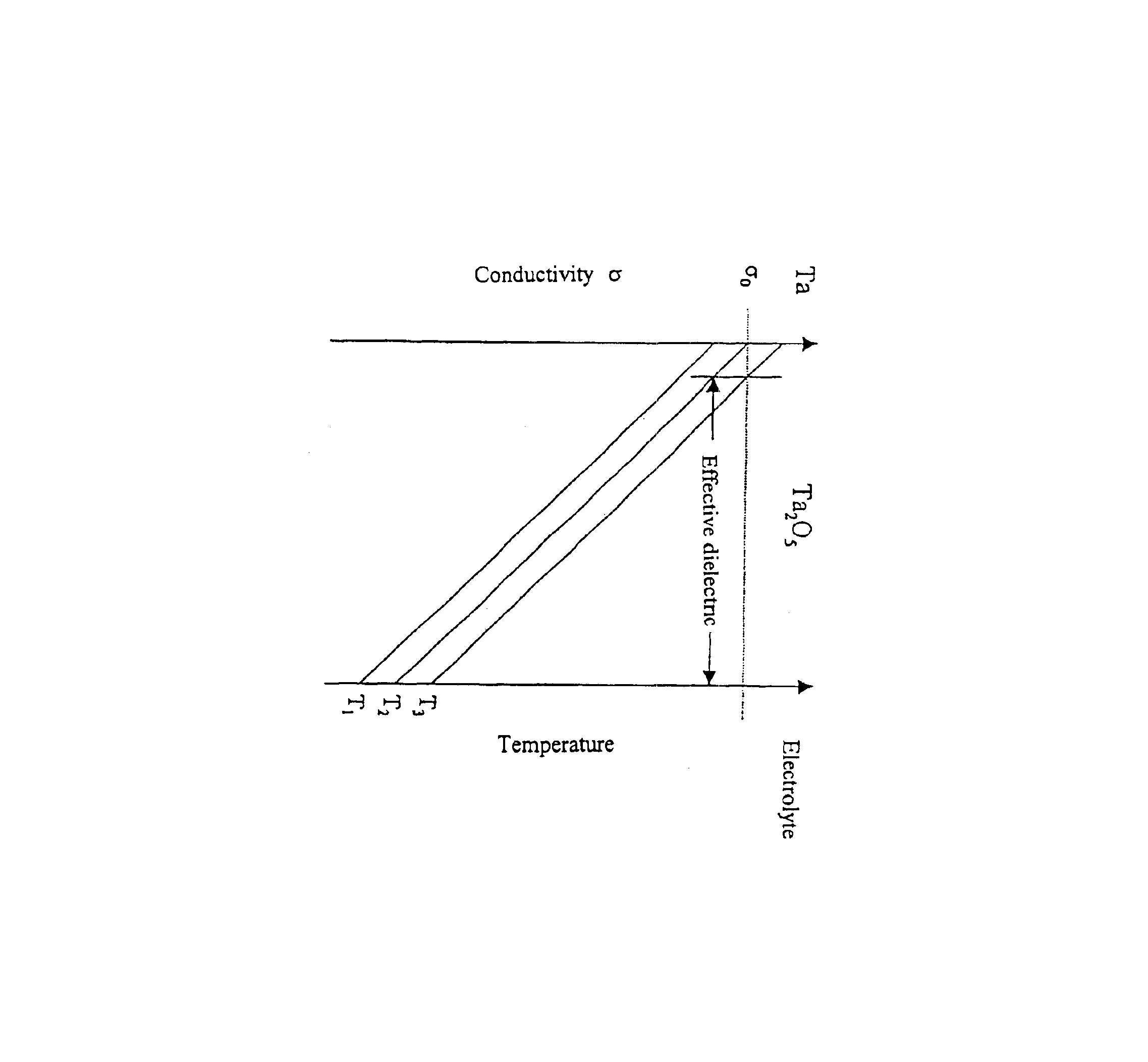Capacitor powder
a technology of electrolytic capacitors and powders, applied in the field of powders for the production of electrolytic capacitors, can solve the problems of increased sensitivity of anodically produced nb/sub>2/sub>5, natural growth limit of achievable specific capacitance, poor quality, etc., and achieve the effect of improving properties
- Summary
- Abstract
- Description
- Claims
- Application Information
AI Technical Summary
Benefits of technology
Problems solved by technology
Method used
Image
Examples
example 1
[0048]A niobium-vanadium alloy containing 0.894% vanadium was prepared as follows: 897.9 g of niobium oxide hydrate Nb2O5*xH2O (Nb2O5 content 63.09%) were intimately mixed with 9.2 g of ammonium metavanadate NH4VO3 dissolved in 1000 ml of H2O, then dried for 24 hours at 110° C. and then calcined for 3.5 hours at 950° C. The Nb2O5xH2O had a primary particle size of approximately 600 nm. The mixed oxide so prepared was then introduced into molybdenum boats and maintained at 1450° C. for 4 hours under a slowly flowing hydrogen atmosphere. The suboxide so obtained had the composition NbO2 (X-ray diffraction) and contained 0.716% vanadium. The product was then placed on a fine-mesh grid beneath which there was arranged a crucible containing magnesium in a 1.1 times stoichiometric amount, based on the oxygen content of the suboxide, and heated for 6 hours at 1000° C. under argon. During that time, the magnesium evaporated off and reacted with the suboxide located above it. After cooling t...
example 2
[0067]A niobium-tantalum-vanadium alloy containing 1.26% vanadium was prepared as follows: 1104.3 g of niobium oxide hydrate Nb2O5*xH2O (Nb2O5 content 67.1%) were intimately mixed with 322.7 g of tantalum oxide hydrate Ta2O5*xH2O (Ta2O5 content 75.4%) and 28.93 g of ammonium metavanadate NH4VO3, then dried for 24 hours at 110° C. and then calcined for 12 hours at 1150° C. The mixed oxide so prepared was then introduced into molybdenum boats and maintained at 1500° C. for 6 hours under a slowly flowing hydrogen atmosphere. The suboxide so obtained had the composition NbO2 (X-ray diffraction shows reflexes displaced only at relatively small angles for NbO2) and contained 21.13% tantalum and 1.05% vanadium. The product was then placed on a fine-mesh grid beneath which there was arranged a crucible containing magnesium in a 1.2 times stoichiometric amount, based on the oxygen content of the suboxide, and heated for 4 hours at 1050° C. under argon. During that time, the magnesium evapora...
example 3
[0088]A niobium(II) oxide powder doped with vanadium (powder A) was prepared as follows: 657.3 g of a niobium-vanadium alloy powder prepared according to Example 1 and having the following purity and physical properties:[0089]V of 6047 ppm[0090]O of 14,500 ppm[0091]Mg of 380 ppm[0092]C of 44 ppm[0093]Σ(Fe, Cr, Ni, Al, Ta)[0094]N of 79 ppm
specific surface area according to BET 4.34 m2 / g, apparent density according to Scott 14.3 g / inch3, flowability according to Hall Flow 22 s, particle size determination according to Mastersizer D10=65.1, D50=170.7, D90=292.7 μm were intimately mixed with 566.5 g of niobium pentoxide Nb2O5[0095]Σ(Al, As, Ca, Co, Cr, Cu, Fe, Ga, K, Mg, Mn, Mo, Na, Ni, Pb, Sb, Si, Sn, Ta, Ti, W, V, Zr)[0096]C[0097]S<10 ppm
and placed into a molybdenum boat. The latter was then heated for 6 hours at 1250° C. under weakly flowing hydrogen. The resulting product (sample A) had the composition NbO and had the following contents and physical properties:[0098]V of 3110 ppm[00...
PUM
| Property | Measurement | Unit |
|---|---|---|
| temperatures | aaaaa | aaaaa |
| BIAS voltage | aaaaa | aaaaa |
| BIAS voltage | aaaaa | aaaaa |
Abstract
Description
Claims
Application Information
 Login to View More
Login to View More - R&D
- Intellectual Property
- Life Sciences
- Materials
- Tech Scout
- Unparalleled Data Quality
- Higher Quality Content
- 60% Fewer Hallucinations
Browse by: Latest US Patents, China's latest patents, Technical Efficacy Thesaurus, Application Domain, Technology Topic, Popular Technical Reports.
© 2025 PatSnap. All rights reserved.Legal|Privacy policy|Modern Slavery Act Transparency Statement|Sitemap|About US| Contact US: help@patsnap.com


